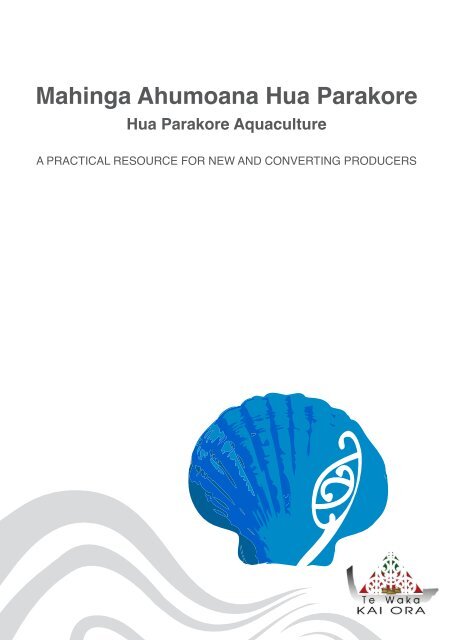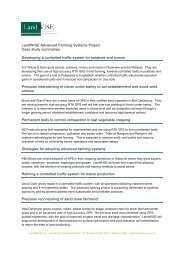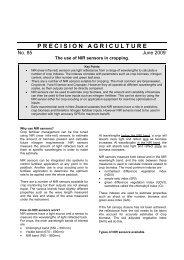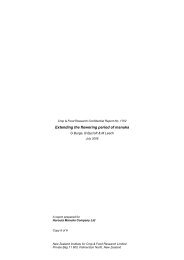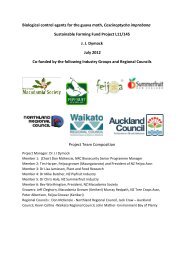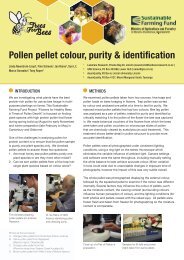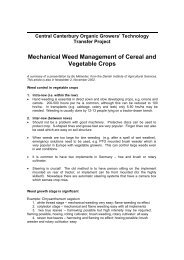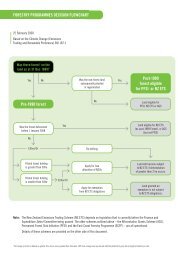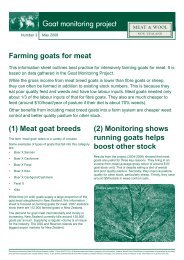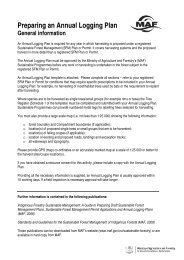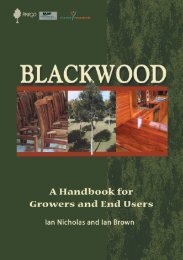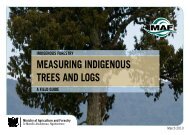Mahinga Ahumoana Hua Parakore - Ministry for Primary Industries
Mahinga Ahumoana Hua Parakore - Ministry for Primary Industries
Mahinga Ahumoana Hua Parakore - Ministry for Primary Industries
Create successful ePaper yourself
Turn your PDF publications into a flip-book with our unique Google optimized e-Paper software.
Te PūTe MoreTe WeuTe AkaTe ReaTe WaoTe KūTe WhēTe KoreTe PōNa Rangi raua kō PapaKo ngā tāngata Māori,Kō tenei te timatanga o te Ao
ISBN 978-0-473-20294-1This research has been completed by Te Waka Kai Ora withfunding assistance from the Sustainable Farming Fund.
!"#$%&'"()*!!"#$%&'"()*!!"#$%&'"()*1Kupu Whakataki - IntroductionThis booklet ‘<strong>Mahinga</strong> <strong>Ahumoana</strong> <strong>Hua</strong> <strong>Parakore</strong>- <strong>Hua</strong> <strong>Parakore</strong> Aquaculture’ is part of a resourceseries compiled by Te Waka Kai Ora (The National Māori Organics Authority of Aotearoa) which aimsto support and encourage sustainable land management and production through the <strong>Hua</strong> <strong>Parakore</strong>process.!<strong>Mahinga</strong> Kairaupī <strong>Hua</strong> <strong>Parakore</strong><strong>Hua</strong> <strong>Parakore</strong> Bee KeepingA PRACTICAL RESOURCE FOR NEW AND CONVERTING PRODUCERS<strong>Mahinga</strong> <strong>Ahumoana</strong> <strong>Hua</strong> <strong>Parakore</strong><strong>Hua</strong> <strong>Parakore</strong> AquacultureA PRACTICAL RESOURCE FOR NEW AND CONVERTING PRODUCERS<strong>Mahinga</strong> Ahuwhenua <strong>Hua</strong> <strong>Parakore</strong><strong>Hua</strong> <strong>Parakore</strong> Pastoral FarmingA PRACTICAL RESOURCE FOR NEW AND CONVERTING PRODUCERS!"#$%&'"()*<strong>Mahinga</strong> Kairaupī <strong>Hua</strong> <strong>Parakore</strong> <strong>Mahinga</strong> <strong>Ahumoana</strong> <strong>Hua</strong> <strong>Parakore</strong> <strong>Mahinga</strong> Ahuwhenua <strong>Hua</strong> <strong>Parakore</strong><strong>Hua</strong> <strong>Parakore</strong> Beekeeping <strong>Hua</strong> <strong>Parakore</strong> Aquaculture <strong>Hua</strong> <strong>Parakore</strong> Pastoral FarmingThe <strong>Hua</strong> <strong>Parakore</strong> korowai is awarded to those who uphold Ngā kaupapa o <strong>Hua</strong> <strong>Parakore</strong> (<strong>Hua</strong><strong>Parakore</strong> principles) through the implementation of Ngā Tikanga o <strong>Hua</strong> <strong>Parakore</strong> (<strong>Hua</strong> <strong>Parakore</strong>practices) to produce Kai Ātua, or the purest products free from all contaminations.‘<strong>Mahinga</strong> <strong>Ahumoana</strong> <strong>Hua</strong> <strong>Parakore</strong>’ provides valuable in<strong>for</strong>mation to support growers to attain the<strong>Hua</strong> <strong>Parakore</strong> korowai. ‘Ngā Tikanga o <strong>Hua</strong> <strong>Parakore</strong>’ is the principal workbook which aspirational<strong>Hua</strong> <strong>Parakore</strong> growers must complete to become verified. ‘<strong>Mahinga</strong> <strong>Ahumoana</strong> <strong>Hua</strong> <strong>Parakore</strong>’ isdesigned to accompany the ‘Ngā Tikanga’ workbook which will feature a section of questions relatingspecifically to aquaculture <strong>for</strong> applicants to answer. .Te Waka Kai Ora offers a national network of support and regional verification <strong>for</strong> aspiring <strong>Hua</strong><strong>Parakore</strong> producers.For more in<strong>for</strong>mation please refer to the back of this resource, or contact us on info@tewakakaiora.co.nz
Acknowledgments to the contributors to this project, in particular Percy Tipene, Leeanne and AdamThompson, Hally Toia, Mahina-a-rangi Baker, Gretta Carney, Theresa Reihana, Tawhai McClutchieand Willie Devine. Thank you also to Te Waka Kai Ora Executive members and to all those who havecontributed to the mahi of Te Waka Kai Ora and <strong>Hua</strong> <strong>Parakore</strong>.Disclaimer: <strong>Hua</strong> <strong>Parakore</strong> privileges the kaupapa and tikanga of individual producers and whānauwho align themselves to <strong>Hua</strong> <strong>Parakore</strong>. The in<strong>for</strong>mation in this publication is a guide only and wewelcome whānau to modify the examples we have provided with those that are uniquely their own.TWKO recommend that you share whakaaro and korero your own Kaumātua/Kuia <strong>for</strong> rohe specifickaupapa and tikanga <strong>for</strong> <strong>Hua</strong> <strong>Parakore</strong>. While every ef<strong>for</strong>t has been made to ensure the in<strong>for</strong>mationin this publication is accurate, Te Waka Kai Ora and its researchers and writers do not accept anyresponsibility or liability <strong>for</strong> error of fact, omission, interpretation or opinion which may be present,nor <strong>for</strong> the consequences of any decisions based on this in<strong>for</strong>mation.<strong>Primary</strong> Researcher - Monique Badham (monique.badham@gmail.com)Design - Alexandra Hart (alexandrahartdesign@gmail.com)Artwork - Theresa Reihana (t.reihana@slingshot.co.nz)
3Contents1. Ngā Tohu mō <strong>Hua</strong> <strong>Parakore</strong>? - What is <strong>Hua</strong> <strong>Parakore</strong>?2. Hei aha te <strong>Mahinga</strong> <strong>Ahumoana</strong> <strong>Hua</strong> <strong>Parakore</strong>? - Why have <strong>Hua</strong> <strong>Parakore</strong> Aquaculture practices?3.Ngā Korero mō te Hahinga <strong>Ahumoana</strong> hei tauira - Aquaculture Case Studiesa. The Thompson’s of Sunshine Oystersb. Hally Toia- An Iwi and Industry Perspective5. Ngā Kaupapa me ngā Tikanga o te <strong>Mahinga</strong> <strong>Ahumoana</strong> <strong>Hua</strong> <strong>Parakore</strong> - Principles and Practicesof <strong>Hua</strong> <strong>Parakore</strong> Aquaculture6. Ngā Tohutao - Recipes7. Ngā wāhi Whakamōhio - Further in<strong>for</strong>mation8. He aha te <strong>Hua</strong>rahi o <strong>Hua</strong> <strong>Parakore</strong> - The process <strong>for</strong> becoming <strong>Hua</strong> <strong>Parakore</strong> verifiedGlossaryĀhuatanga - method, way of doing somethingKai Ātua - foods of highest quality, purity and integrity<strong>Mahinga</strong>- food harvesting practices or activitiesKaitiaki, Kaitiakitanga - guardian, guardianshipKorowai- overlay, cloakNgā Kaupapa - principles or valuesNgā Tikanga- practices that uphold Ngā KaupapaRongoā - natural medicineManaakiatanga - hospitalityRohe - area or regionTīpuna - ancestorTaonga - giftsTohu - label, signTohunga - specialistsWhenua - landKaimoana - food from the aquatic environmentKaimahi - workersTupa - scallopMoana - ocean areas
Ngā Tohu mō <strong>Hua</strong> <strong>Parakore</strong><strong>Hua</strong> <strong>Parakore</strong> is the Te Waka Kai Ora korowaiof excellence <strong>for</strong> mahinga kai and is the Māorihallmark of excellence <strong>for</strong> the production of apure product.<strong>Hua</strong> <strong>Parakore</strong> promotes the re-establishmentof native trade and diverse, vibrant and livingindigenous economies.<strong>Hua</strong> <strong>Parakore</strong> is based on the infinite diversityand richness of the kaupapa of our whānau,hapū and iwi. It is a means of defining a productusing tikanga Māori and creates a pathway <strong>for</strong>growers to tell their story.<strong>Hua</strong> <strong>Parakore</strong> production and tikanga are GE,nano and chemical free and ensure productpurity and integrity.<strong>Hua</strong> <strong>Parakore</strong> is a korowai to NZSA 8410.2003New Zealand Standard <strong>for</strong> Organic Production.<strong>Hua</strong> <strong>Parakore</strong> honors the statements andrights contained within Te Tiriti o Waitangi,The United Nations Declaration of IndigenousPeoples Rights and the Mataatua Declaration.<strong>Hua</strong> <strong>Parakore</strong> aligns to the ethics andaspirations of Slow Food International andNative Trade.The six kaupapa that have been identified byTWKO are illustrated as being encompassedwithin the wider kaupapa of <strong>Hua</strong> <strong>Parakore</strong>.The colours have been used to show thatwhilst each kaupapa has their own distinctivecharacteristics, when considered togetherthey complement one another to produce <strong>Hua</strong><strong>Parakore</strong>.
The Framework of Principles <strong>for</strong><strong>Hua</strong> <strong>Parakore</strong><strong>Hua</strong> <strong>Parakore</strong>When all six kaupapa are expressed togetherthey give rise to <strong>Hua</strong> <strong>Parakore</strong>Whakapapa<strong>Hua</strong> <strong>Parakore</strong> is a connection to the naturalenvironment.Wairua<strong>Hua</strong> <strong>Parakore</strong> maintains peace and safety.Mana<strong>Hua</strong> <strong>Parakore</strong> is a vehicle <strong>for</strong> social justice.Māramatanga<strong>Hua</strong> <strong>Parakore</strong> is a source of enlightenment.Te Ao Tūroa<strong>Hua</strong> <strong>Parakore</strong> maintains natural order.Mauri<strong>Hua</strong> <strong>Parakore</strong> maintains healthy soils, kai andpeople.
6Hei aha te <strong>Mahinga</strong> <strong>Ahumoana</strong> <strong>Hua</strong> <strong>Parakore</strong>?Why have <strong>Hua</strong> <strong>Parakore</strong> Aquaculture practices?The term aquaculture refers to the propagation and rearing of aquatic species. ‘<strong>Ahumoana</strong>’ is anappropriate Te Reo translation <strong>for</strong> aquaculture, but it also casts a wider net to include any <strong>for</strong>mof tiaki ngā mātaitai (care and cultivation of aquatic species), which includes other cultivation orenhancement practices.The sustainability of our kaimoana is a significant issue, and the over-fishing of many of our wildspecies means we must examine other ways to harvest kai. The United Nation Food & AgricultureOrganisation (FAO) also predicts that global consumer demand <strong>for</strong> seafood will almost double from45 to 85 million tonnes by 2015. 1The most dominant aquaculture species in Aotearoa is the indigenous Kūtai (Greenshell TM mussel),comprising around 85% by area, followed by the tio repe (pacific oyster) and king or chinook salmon.Other species include pāua, kina, koura (crayfish), tuna (eels), tuangi (cockles), tio paruparu (nativeflat oysters), inanaga (whitebait), karengo (seaweed) and other finfish such as Hāpuku, are in variousstages of development.The government has targeted the aquaculture industry <strong>for</strong> significant growth of $1billion by 2025,and recent legislative amendments mean that aquaculture is likely to boom in the near future. Theincrease in aquaculture is likely to see Māori participation in the industry rise due to the MāoriCommercial Aquaculture Claims Settlement Act 2004 which gives 20% of new aquaculture spacecreated to iwi.The aquaculture industry, in particular our mussel and oyster species, are marketed as ‘organic’ bydefault as they are dependent on our ‘clean’ waters and do not require any external inputs. Howeveras the scale and intensity of shellfish farming increases so too do the risks to the moana and itsvarious ecosystems.Currently New Zealand exports an estimated 66% of our aquaculture production to over 77 countriesthroughout the world. 2 Global demand <strong>for</strong> aquaculture products sourced from sustainably managedfarms and free from all chemical residues continues to grow.Whānau/hapū/iwi can take advantage of this global demand with the unique added value of <strong>Hua</strong><strong>Parakore</strong> indigenous branding whilst reconnecting to the practices of mahinga ahumoana.<strong>Hua</strong> <strong>Parakore</strong> offers a tikanga and value based system of growing that supports tino rangatiratangaaround our kai and moana.
7Sunshine Oysters in the Kaipara HarbourThe story of Adam and Leeanne ThompsonLeeanne and Adam Thompson (Te Uri o Hau) are running an oyster farm that has been with theirfamily <strong>for</strong> three generations. Adam’s father and his grandfather be<strong>for</strong>e him have all had turns atbeing the kaitiaki of the lease.Their venture is called ‘Sunshine Oysters’ and is located in the Kirikiri Inlet of the Kaipara Harbour.“We have the fastest growing leases in the area. Our oysters are the last to go green and the first toturn white. And they’re sweet. Some people even ask us if we put sugar in the water. I think this isbecause of the lime in the water, and because there is also a current of freshwater that comes past.”The location has a key role to play in producing their delicious oysters. Leanne explains, “It’s a gentleinlet, not exposed. Oysters like that.” Sunshine Oysters currently catch spat on their own ropes,meaning the oysters are naturally occurring and are adapted to the local conditions. The positioningof the farm in relation to others affects their access to plankton, “More kai equals bigger oysters, andif you have farms upstream taking all the plankton out of the water then there is none left when itgets down to us.”Finding kaimahi can be difficult as the work is physical and sometimes mundane. Leeanne andAdam ran a community max program with their local hapū organisation, and these are opportunitiesthat others can use to teach others and get help with labour. They also believe there are goodopportunities <strong>for</strong> tourism enterprises and getting WWOFers (Willing Workers on Organic Farms) orhomestayers to come have an authentic experience.Leeane and Adam used to sell their oysters at the local Whangarei markets, but they have encounteredsome difficulties keeping their operation profitable. Despite these challenges the Thompsons believethat while there aren’t many Māori currently “doing what we do”, the aquaculture industry does havea lot of potential, especially through joint ventures.Oysters have significant commercial potential. Even the shells themselves are valuable and can besold to companies who put it into concrete <strong>for</strong> their pearl-like lustre, and to chicken farmers <strong>for</strong> grit.Leeanne and Adam have concerns around the scale and experimental technologies, such ascaged fish farming that people are bringing into the Kaipara Harbour, especially with overseasinvestor interest increasing.Uplifting the mana of the tangata whenua is important to Leeanne and Adam, “we are going tokoha a portion of our farm to our local marae so they can use it <strong>for</strong> special occasion hui and hakari(feasts)”.Leeanne and Adam have shared korero and practical guidance which features throughout thisresource.
8An Iwi and Industry PerspectiveHally ToiaHally Toia was <strong>for</strong>merly the manager of Natural Resources <strong>for</strong> Te Runanga o Ngāti Whātua <strong>for</strong> 17years, and during this time he has developed a full kete of knowledge around ahumoana and Māoriparticipation.“In terms of <strong>Hua</strong> <strong>Parakore</strong> aquaculture”, says Hally, “the first question you need to ask is whetheror not it needs feed which separates the fin-fish from the shellfish. Shellfish extracts substancesfrom nature, unlike finfish which need external inputs in the <strong>for</strong>m of fish feed and in some casesmedicines.”Hally believes the real future <strong>for</strong> <strong>Hua</strong> <strong>Parakore</strong> aquaculture is in using natural systems and locations<strong>for</strong> cultivation. For example, using the rocks themselves to farm Kūtai on, or harvesting wild stockfrom the rocks and other areas to establish in farms <strong>for</strong> on-growing and enhancement.“At the moment this would be classified as undersized take and comes under the Quota ManagementSystem. But this is more of a culling and enhancement exercise, and is in line with nature and withour traditional tikanga”.Looking to the innovations and practices of our tīpuna provides solutions, says Hally.“Our tūpuna used to use wetland areas <strong>for</strong> harvesting tuna. Wetlands provide easy access andtidal flushing which was good <strong>for</strong> growing the tuna in a confined space and to allow them to leaveto spawn. You could also tie this into to possum control (hunting and not poisoning), and feed thecarcasses to the tuna”, adds Hally.“Whakapapa is a critical question <strong>for</strong> ensuring it is <strong>Hua</strong> <strong>Parakore</strong>. It’s about inter-hapū management,and asking ‘What impact are you having on another rohe by taking the spat out from their moana?’Spat catching on site is the most appropriate as it ensures that they will have the immunity andresistance of the area”Thinking outside the square is at the core of Hally’s philosophy. “Everything we do we have to ask‘why?’ We need to challenge the thinking otherwise we will never work outside the box. We need tostart with the premise that nothing is impossible. Don’t start with the law, because that will limit you.Start with the vision, and then decide how the law can fit into that.”Hally Toia has shared korero and practical guidance which features throughout this resource.
9A Snap Shot of the IndustrySource: Aquaculture New Zealand. www.aquaculture.org.nz
Ngā Kaupapa me ngā Tikanga o te <strong>Mahinga</strong><strong>Ahumoana</strong> <strong>Hua</strong> <strong>Parakore</strong>Principles and Practices of <strong>Hua</strong> <strong>Parakore</strong> AquacultureThis section discusses the <strong>Hua</strong> <strong>Parakore</strong> kaupapa of Aquaculture. Examples of <strong>Hua</strong> <strong>Parakore</strong>tikanga that can be used to implement these kaupapa are provided to guide your own practice andcompletion of the ‘Ngā Tikanga’ workbook. Where there is a specific requirement <strong>for</strong> <strong>Hua</strong> <strong>Parakore</strong>verification that you should be aware of it will be indicated by the Tupa symbol.Whakapapa<strong>Hua</strong> <strong>Parakore</strong> is a connection tothe natural environment.Wairua<strong>Hua</strong> <strong>Parakore</strong> maintains peaceand safety.Mana<strong>Hua</strong> <strong>Parakore</strong> is a vehicle <strong>for</strong> socialjustice.Māramatanga<strong>Hua</strong> <strong>Parakore</strong> is a source ofenlightenment.Te Ao Tūroa<strong>Hua</strong> <strong>Parakore</strong> maintains naturalorder.Mauri<strong>Hua</strong> <strong>Parakore</strong> maintains healthysoils, kai and people.
WhakapapaKo te <strong>Hua</strong> <strong>Parakore</strong> te taawharautanga ki te pūtai ao tūturu<strong>Hua</strong> <strong>Parakore</strong> is a connection to the natural environmentWhakapapa are the natural connections between ngā atua, te whenua, te kai and te tangata inmahinga kai. Knowing this whakapapa, how everything in the mahinga kai interacts and relates toeach other, is fundamental to knowing how things that are put into the mahinga kai will impact andinfluence everything else.<strong>Hua</strong> <strong>Parakore</strong> producers will have to consider this in the management of theirproduction unit and be prepared to answer questions on tikanga they implement touphold the kaupapa of whakapapa in the ‘Ngā Tikanga’ workbook to become verified<strong>Hua</strong> <strong>Parakore</strong>.
13Ngā Tikanga<strong>Hua</strong> <strong>Parakore</strong> producers need to consider the following management questions to become verified<strong>Hua</strong> <strong>Parakore</strong>:• Describe your operation? [Marine, freshwater, land based, wild harvest]• What species are you growing?• Do you breed your own replacement stock? If so you need to describe your breeding regime. If not,where do you source your replacement stock?• Does the species used occur naturally in the environment?• Is this species appropriate <strong>for</strong> your local conditions?• Where do you source your species? How can you be confident of the integrity and purity of this stock?• What is your production method? [Racks, ropes, cages, natural enhancement, natural ecosystemharvest, land-based]• What are your cultivation methods? [Including age, breed and frequency of harvest]• What is the approximate amount produced each year?• What are the main sources of food <strong>for</strong> your animals?• Do you use any dietary supplements?• Where do your various activities occur? You will need to record this on a map.• Who is responsible <strong>for</strong> the management of your mahinga ahumoana? How do you ensure that <strong>Hua</strong><strong>Parakore</strong> kaupapa is maintained?Finfish farming• Where do you source the fishmeal? How can you be confident of the integrity and purity of this feed?<strong>Hua</strong> <strong>Parakore</strong> producers must follow these guidelines to become verified <strong>Hua</strong> <strong>Parakore</strong>:Care should be taken when selecting the species to ensure they are appropriate <strong>for</strong> yourlocal conditions.Wild harvest of kaimoana is permitted where the area is clearly identified, and there are noconcerns of contamination (including its location to any non <strong>Hua</strong> <strong>Parakore</strong> aquaculture).Preference should be given <strong>for</strong> self-collection of spat or <strong>for</strong> species within your rohe.Genetically engineered, hybridised or sex-altered animals are not <strong>Hua</strong> <strong>Parakore</strong>.If you source your spat from a hatchery it must be a <strong>Hua</strong> <strong>Parakore</strong> verified hatchery.All inputs including fishmeal should be <strong>Hua</strong> <strong>Parakore</strong> or organically sourced, andpreferably from an aquaculture source rather than wild capture where available.Mapping records are an integral part of good management practice and supportconsistency, product traceability and succession planning. The ‘Ngā Tikanga’ workbookwill require you to complete detailed mapping.
14Whakapapa o ngā <strong>Ahumoana</strong>Genealogy of Aquaculture in AotearoaAccounts of whakapapa of aquaculture species varies across different regions and iwi, howeversome of the key deities of aquaculture species that have been documented are:• Kaukau; the personification of swimming• Te Rōpūwai; the gathering of waters• Hinemoana; who gave birth to shellfish and her offspring Hungaterewai; producer of univalves,welks, limpets and oysters, and Te Arawarua and Kaumaihi; producer of the cockle family.Through whakapapa, shellfish (and mussels in particular) are also connected to rocks, gravel, sandand seaweed. Hinemoana also produced Wharerimu; seaweed in all its <strong>for</strong>ms, which she placed withRakahore and Tuamatua; personification of rock and stones, to provide shelter and protection <strong>for</strong>the shellfish. The shellfish also served as companions <strong>for</strong> Hinetūākiri (gravel) and Hineone (sand). 3Over the centuries Māori have developed many harvesting and cultivation practices <strong>for</strong> kai in thevarious aquatic environments. Many of these practices were driven by the importance kaimoanaplayed in the diet of Māori, as well as its role in manaakiatanga <strong>for</strong> customary occasions, and in theeconomic and trading relationships between different groups.The exclusion of Māori from this traditionally significant industry gave rise to a Waitangi Tribunal claim(Wai 953), and the subsequent Māori Commercial Aquaculture Claims Settlement Act, 2004 whichprovides a ‘full and final settlement of Māori commercial aquaculture interests’ through providing theequivalent of 20% of space created since 1992, and 20% of all new space.Māori aquaculture practices were extensive, and ranged from transplanting of shellfish beds,enhancement and habitat protection practices, planting mussels on rocks, and <strong>for</strong>ming enclosedhabitats such as rock pools. The Ahu Moana Report (Wai 953) includes many stories of suchpractices;“Te Atiawa Kaumatua George Martin recalls his mother-in-law farming green-lipped mussels morethan fifty years ago, off Onauku in East Bay. She would place boulders in circles, about two feethigh, and within these put smaller boulders with the mussels attached to them, leaving them tobreed. These would be set at low spring tides, and replenished annually. The boulders still remainwhere they were placed all those years ago, but their stocks have not been kept up by youngergenerations.” (Waitangi Tribunal, 2002: p60). 4Hally Toia (Ngāti Whātua) states that “In times gone by, we would have used rock pools. They wouldhave taken pāua from the ocean and put them into rock pools <strong>for</strong> enhancement this would have beencommon practice. It’s a simple logic, people lived by the oceans and they wanted to be sure thatwhen their respected manuhiri came to stay that they had their prized species there to serve them.”
WairuaKo te <strong>Hua</strong> <strong>Parakore</strong> te Kaitiakitanga o te humariretanga me te ora<strong>Hua</strong> <strong>Parakore</strong> maintains peace and safetyWairua is the spiritual health and peace of the whenua, the kai and tāngata. Protecting and havingrespect <strong>for</strong> the wairua of those who do mahinga kai is important <strong>for</strong> the safety of kaimahi, but also<strong>for</strong> the safety of the kai they produce; the purity and health of the wairua of the kaimahi directlyinfluences the purity and the health of the kai.<strong>Hua</strong> <strong>Parakore</strong> producers maintain management practices that enhance and protectwairua. The kaimahi are an integral part of <strong>Hua</strong> <strong>Parakore</strong> practice. It is importantthat their wairua is protected by ensuring they don’t work at inappropriate times andthat sound conflict resolution tikanga are used. <strong>Hua</strong> <strong>Parakore</strong> producers will have toconsider this in the management of their production unit and be prepared to answerquestions on tikanga they implement to uphold the kaupapa of wairua in the ‘NgāTikanga’ workbook to become verified <strong>Hua</strong> <strong>Parakore</strong>.
ManaKo te <strong>Hua</strong> <strong>Parakore</strong> te waka mō te pono me te tika<strong>Hua</strong> <strong>Parakore</strong> is a vehicle <strong>for</strong> justiceMana is the autonomy, security and self-determination of iwi, hapū and whānau through mahinga kai.It is important that the benefits and success that are derived from mahinga kai are shared with yourwider community and local economy, and that equally; the mahinga kai is supported and nurtured byyour community and local economy.<strong>Hua</strong> <strong>Parakore</strong> is a holistic system that considers social justice and the rights of tangatawhenua embedded in Te Tiriti o Waitangi to be of central importance. <strong>Hua</strong> <strong>Parakore</strong>asks you to consider how your practice has positive effects <strong>for</strong> your Whānau, andwider community beyond individual success. You will need to answer questionsaround uplifting the Mana of te tangata in the ‘Ngā Tikanga’ workbook.
MāramatangaKo te <strong>Hua</strong> <strong>Parakore</strong> te huarahi o te māramatanga mai tawhiti<strong>Hua</strong> <strong>Parakore</strong> is a source of enlightenmentMāramatanga is the insight and enlightenment we gain through mahinga kai. <strong>Hua</strong> <strong>Parakore</strong> productionrelies on māramatanga through observance and understanding of nature, in particular the rhythmsand vibrations of the māramataka and seasonal energies.<strong>Hua</strong> <strong>Parakore</strong> producers should ensure they can demonstrate the māramatanga theyengage with to guide their practices. Having an intimate knowledge of your area throughobservation is also an important part of being a <strong>Hua</strong> <strong>Parakore</strong> producer; using divinesenses (sight, smell, hearing, taste, touch, and a connection to the intangible) is centralto upholding this principle. <strong>Hua</strong> <strong>Parakore</strong> producers will have to consider this in themanagement of their production unit and be prepared to answer questions on tikangathey implement to uphold the kaupapa of māramatanga in the ‘Ngā Tikanga’ workbookto become verified <strong>Hua</strong> <strong>Parakore</strong>.
19Ngā Tikanga<strong>Hua</strong> <strong>Parakore</strong> producers need to consider the following management questions to become verified<strong>Hua</strong> <strong>Parakore</strong>:• What tohu and knowledge do you use to guide you in understanding your local environment?[Māramataka, seasonal knowledge, environmental indicators]• Where do you go <strong>for</strong> in<strong>for</strong>mation and knowledge?• What learning and education have you or your kaimahi undertaken to improve māramatanga inyour mahinga kai? [Wānanga, workshops, qualifications, lessons from kaumātua/kuia]• How is your mahinga kai used to educate within your wider community?“We use ropes <strong>for</strong> our oyster farm as they are cheaper and use less timber. Stickfarms are closer together - about 1m apart, whereas ropes are about 6m apart. Thisallows more sediment to pass through, and more water flowing past which is better<strong>for</strong> growth rates. We’ve tested the optimal size of the ropes, and just because youuse a thicker rope it doesn’t mean you’ll get more oysters. We’ve found the optimalsize is around 4mm”, Sunshine Oysters.
20Recent Legislative Re<strong>for</strong>msRecent re<strong>for</strong>ms to the legislation controlling aquaculture are likely to see the industry grow in thecoming years. This supports the current governments ‘Economic Growth’ agenda, and its aim to seethe industry reach ‘$1 billion by 2025’. Since the 2004 aquaculture re<strong>for</strong>ms which introduced thecreation of AMAs (Aquaculture Management Areas), no additional water space <strong>for</strong> aquaculture hasbeen created. As of the 1st of October 2011 marine farms must follow the same resource consentprocesses (under the RMA) that are required by any other activity in the coastal marine area.Councils can still identify areas where aquaculture activities cannot occur, and include provisions intheir regional coastal plans to manage aquaculture. The Undue Adverse Effects (UAE) test under the<strong>Ministry</strong> of Fisheries still exists, but it is streamlined and integrated more into the resource consentprocess, and there is an emphasis on reaching a negotiated agreement with Quota holders prior tothe test commencing. 5Māori Commercial Aquaculture Claims Settlement Act, 2004The legislative re<strong>for</strong>ms also affect the Māori Commercial Aquaculture Claims Settlement Act, 2004(‘Settlement Act’) which was originally written to work within the AMA system. Under the new re<strong>for</strong>ms,the Crown will enter into regional agreements with Iwi (to mandated Iwi Aquaculture Organisations)to deliver the settlement.The 2011 aquaculture law re<strong>for</strong>ms remove the requirement <strong>for</strong> AMAs to be established be<strong>for</strong>e newspace <strong>for</strong> aquaculture activities can be applied <strong>for</strong>. Because of this change a new delivery mechanism<strong>for</strong> the settlement has been developed. Through the regional agreement process deliverables <strong>for</strong> thesettlement may include space, cash, or anything else that is agreed to. Negotiated settlements maybe based on anticipated new aquaculture development over a period of time or another arrangementthat Iwi and the Crown determine to be equitable. The agreed deliverables are transferred to thetrustee <strong>for</strong> allocation to Iwi. Some councils will need to undertake additional planning work to identifysuitable areas <strong>for</strong> aquaculture and enable resource consent applications to be made in areas notpreviously allowed. 6For more detailed explanation on the settlement act, visit the websitewww.aquaculture.govt.nz/files/tech_guide_2011/2011_settlement.pdf
Te Ao TūroaMa te <strong>Hua</strong> <strong>Parakore</strong> e Kaitiaki i ngā Tikanga tuku iho o te Maara Kai<strong>Hua</strong> <strong>Parakore</strong> maintains natural orderTe Ao Tūroa is the natural order of our world. It is an expression of the divinity of the atua. Our roleas tangata whenua of Aotearoa is to act as kaitiaki of Te Ao Tūroa. In your role as a <strong>Hua</strong> <strong>Parakore</strong>producer, it is important to respect and protect the integrity and sanctity of Te Ao Tūroa in order toensure the quality of Kai Ātua that you produce.<strong>Hua</strong> <strong>Parakore</strong> producers act as kaitiaki to the animals and the environment. Ensuringthat nature is able to take its own course is an important management feature <strong>for</strong><strong>Hua</strong> <strong>Parakore</strong>. <strong>Hua</strong> <strong>Parakore</strong> producers understand how appropriate location andstock densities affect both the species wellbeing, and the ability <strong>for</strong> the environmentto absorb any impacts. <strong>Hua</strong> <strong>Parakore</strong> producers will have to consider this in themanagement of their production unit and be prepared to answer questions on tikangathey implement to uphold the kaupapa of Te Ao Tūroa in the ‘Ngā Tikanga’ workbookto become verified <strong>Hua</strong> <strong>Parakore</strong>.
23Ngā Tikanga<strong>Hua</strong> <strong>Parakore</strong> producers need to consider the following management questions to become verified<strong>Hua</strong> <strong>Parakore</strong>:• What are the potential environmental impacts of your operation? How do you manage theseimpacts?• How do you ensure the site of your operation is appropriate? [Tidal flushing, water depth, currentspeeds]• What are the stocking densities? [Numbers, spacing] Can you ensure this density does notcompromise the welfare of the animals?• How does your management practice minimise stress to the animals and enable them to displaynatural behaviour?• Do you slaughter animals? If so you will need to explain how your slaughter practices minimizestress or trauma to your animals.• What ef<strong>for</strong>ts do you make to protect and enhance the water quality <strong>for</strong> your species?• Do you transport the animals - if so how do you minimise stress and harm?• If you harvest seaweed or other naturally occurring species, what is the sustainable harvest yield?Cage farming• How do you manage and prevent escapes?• How do you protect fish against predation by other animals?Land-based• What are your water sources?• What are your effluent management plans?• What are your light regimes?• What filtering techniques do you use to control and recylce waste and nutrients.• Do you use aeration?• Do you use settling ponds, biological or mechanical filters?• If it is an open system, how do you ensure the mauri of the water leaving the farm is maintained?• How do conserve energy? [Recycling of waste, using renewable energy sources]• What are your cleaning practices? Do you use any chemicals?• What testing do you do? [Suspended solids, oxygen, salinity]<strong>Hua</strong> <strong>Parakore</strong> producers must follow these guidelines to become verified <strong>Hua</strong> <strong>Parakore</strong>:You should minimise the negative effects of your farm on the surrounding environment andecosystems as much as possible (and in accordance with the Resource Management Act)through good design, selection of appropriate species, density, materials and location.
24Your stocking rates and density of animals must not compromise animal welfare andshould enable the species to display natural patterns of behaviour.Material used must not contain chemicals or synthetic elements that may harm thesurrounding ecosystem. Appropriate management should minimise the risk of escapes,and all escapes should be recorded.You should ensure appropriate cleaning regimes that do not use harmful chemicals.Your slaughtering practices must minimise handling and harm to the animals.Transporting live animals should be minimised, but if required the animals needs andwelfare must be met during transit.Land basedYou must document any use of aeration.The use of artificial light should be minimised to enable natural patterns of behaviour.Environmental parameters such as temperature, dissolved oxygen, salinity andsuspended solids must not fluctuate drastically within the system, and appropriate testingwill need to be carried out to ensure this.You should remove waste such as faeces and uneaten food from the water to reducerisks of disease and poor water quality.Te <strong>Mahinga</strong> <strong>Ahumoana</strong> me te Ahua o te Taiao - Environmental Impacts ofAquacultureAquaculture in New Zealand, particularly the mussel and oyster sector, has an international reputationas being sustainable activity. New Zealand’s Greenshell Mussels have been recognised by theInternational Conservation Organisation Blue Ocean Institute as one of the top two ‘eco-friendlyseafood’s’ in the world. 7 Our rigorous export testing regimes means NZ growers can access someof the most regulated markets without the need of depuration (placing shellfish into clean water todecontaminate). However this current reputation is based on our relatively low water pollution ratesand low density of aquaculture farms. As the scale increases and our human impacts on the coastalenvironment increases, the ‘sustainability’ of our shellfish farms will also be challenged. Most of theeffects stem from feeding and waste products or the physical presence of farm structures in themarine environment.More research has been conducted in the past five years as concerns around the cumulative effectson a growing industry have mounted. Most of the effects stem from feeding and waste products orthe physical presence of farm structures.Polyculture - Companion Planting with KaimoanaThe National Institute of Water and Atmosphere (NIWA) and the HongoekaDevelopment Trust (in Plimmerton) are collaborating on New Zealand’s firstlow-cost, land-based polyculture system. Polyculture is much like companionplanting on land, and involves the rearing of different trophic level species that areecologically compatible (and don’t compete <strong>for</strong> the same resources). The projectuses a recirculation water system and uses four main species; Pāua, bivalves(mussels worked best to remove the suspended solids), karengo (a seaweed whichremoves the dissolved ammonia), and sea cucumbers (which remove the settledsolids). Best of all it’s designed to be a low cost land-based option, meaning it willviable <strong>for</strong> many Coastal Māori to pursue. 8
25Effects of Shellfish farmingThe environmental effects of shellfish farming are similar across most species (mussel, oyster etc). Theeffects can be discussed broadly under three areas- seabed, water column, and wider ecological effects. 9Ecological Effects of Shellfish Aquaculture. (Keeley et al. 2009). © <strong>Ministry</strong> of Fisheries. 7Seabed EffectsOne impact can be the enrichment of organic matter below the farms which can create habitats <strong>for</strong> certainspecies that thrive underneath. These seabed effects are dependent on water current, depths and speeds,and can be minimised by appropriate site selection.Water Column EffectsThe physical presence of farms can reduce current speeds which can affect other biological processes.Bivalves also release ammonium into the water which can stimulate phytoplankton growth. Selectivefeeding by the shellfish can also affect the ecology of the area.Wider Ecological IssuesThere are a wide range of potential ecological effects of aquaculture. Farms can function as mid-waterartificial reefs, making habitats <strong>for</strong> other species, and can contribute to seabed enrichment through biodeposits.It can also increase the risks of disease and pests spreading by acting as reservoirs. Effects onother mammals and seabirds, including entanglement, is another issue. To date reported entanglementsare low due in part to the ‘coastal-ribbon’ development pattern of aquaculture, but this may increase withmore off-shore marine farming. The effects on genetic diversity are not deemed to be high as the source ofmost progeny is from the wild as opposed to hatcheries.MitigationMany of these effects can be mitigated by good site selection, in a location that have strong currents tohelp dissipate waste, good food supplies <strong>for</strong> the extractive bivalve species and are placed away fromsensitive habitats.
26Effects of Finfish FarmingOur finfish farming sector is small, and focuses mostly on the sea cage farming of king or chinooksalmon in the Marlborough Sounds, Akaroa harbour and Stewart Island. There have also been someexperimental investigations into kingfish and groper. The main issues are around the artificial feedin the <strong>for</strong>m of pellets, and the uneaten food and faeces that drop onto the seabed. 10 The main issuesto consider when verifying the <strong>Hua</strong> <strong>Parakore</strong> status of finfish farming are: the use of artificial feed inthe <strong>for</strong>m of pellets, the uneaten food and faeces that drop onto the seabed, the source of feed, theability <strong>for</strong> the fish to demonstrate natural patterns of behaviour and minimizing stock density.WATER COLUMNEFFECTSLOCALISED SEABEDEFFECTSWIDER ECOLOGICALEFFECTSFeed inputPhytoplanktonand primaryproductionFlushing by waves & currentsWaves & currentsEffects of farm structuresNutrientsArtificialreefhabitatFish disease andgenetic transferBiosecurity and transferof fouling pestsSeabirds andmarine mammalsHarmfulalgal bloomsTrace contaminantsand therapeutantsOther seabedeffectsFishfaecesUneatenfeedSediment-waterexchangesWild fishFaecesDepositional footprintSeabed fish and epibiotaSeafloor sedimentsEcological Effects of Finfish Aquaculture. (Forrest et al 2007). © <strong>Ministry</strong> of Fisheries. 11Aquaculture can also affect the natural balance of the global ecosystem due to the reliance ofcarnivorous species on fishmeal which is currently derived from the wild fisheries. The reliance ofmuch of the aquaculture industry on wild-spat as opposed to hatchery reared juveniles means it isnot operating in a ‘closed-cycle’ and hence effects the wider food chain. 12However aquaculture is an activity that is dependent on good environmental conditions, especially<strong>for</strong> bivalve species such as mussels and oysters which filter feed nutrients as well as harmful toxins.They can be understood as the ‘canaries of the ocean’ in that they are tohu <strong>for</strong> the health of tangaroa.Aquaculture also encourages good catchment management schemes, and marine farmers oftenlobby against land-use degradation such as that caused by agricultural and <strong>for</strong>estry run off andindustrial pollution into waterways.
MauriMa te <strong>Hua</strong> <strong>Parakore</strong> e kaitiaki te ora o te pae o Papa-tū-ā-nuku,te ora o ngā hua me ngā rakau katoa o Tāne, otira, me te ora o tetinana o ngā tāngata katoa<strong>Hua</strong> <strong>Parakore</strong> maintains healthy soils, healthy plants and healthy peopleMauri is the principal essence of life. It is important to protect the mauri and thus the health of thevarious elements of your mahinga kai to ensure the quality and integrity of the food it produces ishigh and that the people who consume it are healthy.<strong>Hua</strong> <strong>Parakore</strong> producers ensure they have an awareness of the various threats thattheir species may face so that they can effectively manage risk and ensure the mauriof the environment is maintained. Aquaculture can be practiced in a way that protectsand enhances the mauri, and encourages good water quality management. The bestmethod of disease control is prevention through selection of strong breeds, good siteand technology choices, and constant observation. <strong>Hua</strong> <strong>Parakore</strong> producers will haveto consider this in the management of their production unit and be prepared to answerquestions on tikanga they implement to uphold and enhance Mauri in the ‘Ngā Tikanga’workbook to become verified <strong>Hua</strong> <strong>Parakore</strong>.
29Ngā Tikanga<strong>Hua</strong> <strong>Parakore</strong> producers need to consider the following management questions to become verified<strong>Hua</strong> <strong>Parakore</strong>:• What are your main pest and disease risks and concerns?• How do you manage pests and diseases?• When disease treatment is required, what do you use?• What is your management plan <strong>for</strong> dealing with water pollution and other emergencies?• Are there any potential sources of pollution or contamination that may affect your mahinga?<strong>Hua</strong> <strong>Parakore</strong> producers must follow these guidelines to become verified <strong>Hua</strong> <strong>Parakore</strong>:Preference should be given to rongoā, homeopathic, and other natural treatments. Theuse of allopathic or chemically synthesised medications must only be used when thereare no other alternatives (unless required by law).If you have to use allopathic treatments you will need to keep the affected stock inisolation <strong>for</strong> an appropriate period. Any restricted treatments must be stored securelyand noted in your rātaka. To prevent contamination, you must not store any prohibitedinputs on your mahinga.Your mahinga must be located an appropriate distance from any contamination sources.This could include water borne chemicals, sewerage, rubbish or risks posed by extremeweather events.
31Ngā TohutaoRecipesThai Kūtai1 Tbsp peanut oil (or any other oil)1/2 C very thinly sliced yellow onions1 Tbsp thinly sliced garlic2 Tsp minced fresh ginger2 chillies, minced1 C fish stock2 Tbsp lime juice2 Tsp sugar1kg New Zealand Green Shell Mussels, well rinsed, beards removed, any open mussels discarded1 C coconut milkChopped coriander and mint leavesIn a large pan or saucepan heat the oil over medium-high heat. Add the onions and cook, stirring,until soft, 2 to 3 minutes. Add the garlic, ginger, and chilli, and cook, stirring, until fragrant (around 1minute). Add the stock, lime juice and sugar, and stir well. Add the mussels and bring to a boil. Coverand cook, shaking the pan until the mussels open (about 2 minutes). Add the coconut milk, corianderand mint, and stir well to combine. Cook until the coconut milk is warmed through, about 1 minute.Remove from the heat and serve in deep bowls. Serve with French bread.Trinity Oysters36 Pacific Oysters on the half shellBasil Butter:60g butter2 Tbsp chopped fresh basil2 Tbsp grated parmesan cheese1 clove garlic, crushed1/4 C grated parmesan cheese, extraHave butter at room temperature. Beat butter in bowl until smooth, stir in basil, cheese and garlic.Divide over 12 oysters, grill until butter is melted.
32Ngā wāhi WhakamōhioFurther in<strong>for</strong>mationOrganisationsThe following organisations offer support and in<strong>for</strong>mation <strong>for</strong> producers that you may find useful:Soil and Health Associationwww.organicnz.orgAbalone (Pāua) Industry GroupThe Association was established to become a key contact <strong>for</strong> investors, new farmers and firmswishing to do business with the New Zealand Paua farming sector.www.nzafa.org.nzAquaculture New Zealand- Aquaculture Industry GroupAquaculture New Zealand is an aquaculture industry group that promote aquaculture development.www.aquaculture.org.nz/The New Zealand Seafood Industry Council LtdThe New Zealand Seafood Industry Council Ltd works on behalf of the New Zealand seafoodindustry. The industry is made up of about 2500 participating enterprises, including fishermen andaquaculturists and family-owned, publicly listed and joint venture seafood companies, fisheriesmanagement organisations and retailers.www.seafoodindustry.co.nz/sc-aboutOrganic CertifiersIf you wish to find out more about organic certification and their standards:AsureQualitywww.organiccertification.co.nzBiogrowww.biogro.co.nz/index.php/Demeter (assessing against BioDynamic principles).www.biodynamic.org.nz/Organic Farmwww.organicfarm.org.nz
33Technical RulesThe following websites provide further in<strong>for</strong>mation on rules and guidelines:New Zealand Food Safety AuthorityTechnical Rules <strong>for</strong> the Official Organics Assurance Programme <strong>for</strong> exported product.www.nzfsa.govt.nz/organic/documents/index.htmCanadian Standardswww.tpsgc-pwgsc.gc.ca/cgsb/on_the_net/organic/index-e.htmlUnited States Department of Agriculture National Organic Standardwww.organiccertification.co.nz and click on the USDA NOP link on the home page.Biosecurity New Zealandwww.biosecurity.govt.nz/Publications and ResearchThe following are useful publications and research freely downloadable on the internet:Aquaculture New ZealandANZ website has a range of useful publications, including a marine farmer guidewww.aquaculture.org.nz/National Institute of Water & Atmospheric ResearchWebsite has useful in<strong>for</strong>mation and reports on aquaculturewww.niwa.co.nzTe Puni Kokiri (<strong>Ministry</strong> of Maori Development)Provides in<strong>for</strong>mation <strong>for</strong> Maori interested in aquaculture.http://www.tpk.govt.nz/en/‘TPK (2009) <strong>Ahumoana</strong> Ahutangata, Aquaculture Development in New Zealand: Scientific andTechnical In<strong>for</strong>mation to In<strong>for</strong>m Maori’www.tpk.govt.nz/mi/in-print/our-publications/publications/ahumoana-ahutangataaquaculturedevelopment-in-new-zealand-scientific-and-technical-in<strong>for</strong>mation-to-in<strong>for</strong>m-maori/download/tpkaquaculturefullreport-2009-en.pdf
34He aha te <strong>Hua</strong>rahi o <strong>Hua</strong> <strong>Parakore</strong>?If the <strong>Hua</strong> <strong>Parakore</strong> kaupapa detailed in this resource resonate with you and your whānau then TeWaka Kai Ora can offer a clear pathway to support you in starting up your own enterprise.Attain the <strong>Hua</strong> <strong>Parakore</strong> Korowai in 3 easy steps:1. Ngā Kaupapa1. NgāKaupapa:Join the <strong>Hua</strong> <strong>Parakore</strong> kaupapa! Take the first step to becoming a <strong>Hua</strong> <strong>Parakore</strong> producer bycompleting the application <strong>for</strong>m at the back of this resource and sending it into us and we will sendyou back the resources you need to get started.2. Ngā 2. Tikanga NgāTikanga:He aha ngā Tikanga ō koutou kaupapa <strong>Hua</strong> <strong>Parakore</strong>? Ngā tikanga is what we do in our mahingakai to uphold Ngā Kaupapa and produce Kai Ātua. Ngā tikanga can be specific to producers’ rohe,iwi, hapū and whānau. Record the tikanga you implement to uphold <strong>Hua</strong> <strong>Parakore</strong> in your mahingakai in your ‘Ngā Tikanga o <strong>Hua</strong> <strong>Parakore</strong>’ workbook.3. Ngā<strong>Hua</strong>3. Ngā <strong>Hua</strong>He aha ngā <strong>Hua</strong> ō Koutou Kaupapa <strong>Hua</strong> <strong>Parakore</strong>? Ngā <strong>Hua</strong> are the outcomes or products whichresult from implementing ngā Tikanga. Each year <strong>Hua</strong> <strong>Parakore</strong> producers verify Ngā <strong>Hua</strong> througha robust whānau, rohe and national kaitiaki process.The <strong>Hua</strong> <strong>Parakore</strong> korowai is awarded in your third year of implementing the kaupapa.Year OneYear Two Yearree!"!"#$ KAKANOTIPU !"#$%&'()' RANGANgā Āhuatanga o <strong>Hua</strong> <strong>Parakore</strong>: Resource 3 Ngā Āhuatanga o <strong>Hua</strong> <strong>Parakore</strong>: Resource 4 Ngā Āhuatanga o <strong>Hua</strong> <strong>Parakore</strong>: Resource 4
35There are four booklets in the Ngā Ahutanga of <strong>Hua</strong> <strong>Parakore</strong> kete that will help guide you throughthe process.Ng huatanga o<strong>Hua</strong> <strong>Parakore</strong>:Resource 1Resource 1 - ‘Te Papawhairiki mō <strong>Hua</strong> <strong>Parakore</strong>’ provides an outline of the purposeand structure of Te Waka Kai Ora and introduces you to the process of <strong>Hua</strong><strong>Parakore</strong>. Te Papawhairiki mō <strong>Hua</strong> <strong>Parakore</strong> resource is freely available online orthrough contacting Te Waka Kai Ora.Ng huatanga o<strong>Hua</strong> <strong>Parakore</strong>:Resource 2Resource 2 - ‘Ngā Kaupapa o <strong>Hua</strong> <strong>Parakore</strong>’ provides you with in<strong>for</strong>mation and anunderstanding of the six key kaupapa that in<strong>for</strong>m and guide ‘Ngā Tikanga o <strong>Hua</strong><strong>Parakore</strong>’. Full of beautiful korero from <strong>Hua</strong> <strong>Parakore</strong> producers and kaumatua/kuia throughout the motu, the Ngā Kaupapa o <strong>Hua</strong> <strong>Parakore</strong> resource is availablefrom the Te Waka Kai Ora website at a cost of $20.Ng huatanga o <strong>Hua</strong> <strong>Parakore</strong>:Resource 3Resource 3 - ‘Ngā Tikanga o <strong>Hua</strong> <strong>Parakore</strong>’ is the principal workbook which providesuseful templates <strong>for</strong> you to record the tikanga that you implement and record allinputs into your mahinga kai. It also includes templates <strong>for</strong> you to complete whānauand rohe whakapūmau or verification. Kaitono (applicants) will receive their copyof the Ngā Tikanga o <strong>Hua</strong> <strong>Parakore</strong> workbook from Te Waka Kai Ora upon receiptof your application <strong>for</strong>m and fee.Ng huatanga o<strong>Hua</strong> <strong>Parakore</strong>:Resource 4Resource 4 - ‘Ngā <strong>Hua</strong> o <strong>Hua</strong> <strong>Parakore</strong>’ provides producers with a template torecord annually Ngā <strong>Hua</strong> (the end products and outcomes) and to confirm yourverification and validation as <strong>Hua</strong> <strong>Parakore</strong> producers. This is <strong>for</strong> producers whohave already completed the Ngā TIkanga o <strong>Hua</strong> <strong>Parakore</strong> workbook and kaitonowill receive their annual copy at Matariki each year, to be returned the followingMatariki.New Kaitono (applicants) enter the ‘kākano’ stage in their first year, and will need to submit theircompleted Ngā Tikanga o <strong>Hua</strong> <strong>Parakore</strong> workbook to the Kaitikai Roopu be<strong>for</strong>e moving onto theTipu Ranga stage. A panui calling kaitono to submit their workbooks is sent out prior to Matariki.Please fill out the <strong>for</strong>m at the back of this resource, visit our website: www.tewakakaiora.co.nz andfill out the <strong>for</strong>m online, or send us an email at info@tewakakaiora.co.nz‘<strong>Mahinga</strong> <strong>Ahumoana</strong> <strong>Hua</strong> <strong>Parakore</strong>’ provides valuable in<strong>for</strong>mation to support farmers to attain the<strong>Hua</strong> <strong>Parakore</strong> korowai. Refer to the in<strong>for</strong>mation provided here as you plan and document the tikangayou implement in your mahinga kai/aquaculture enterprise.
36FAQ’sHow long does it take to become <strong>Hua</strong> <strong>Parakore</strong> verified?In most cases there is a minimun period of three years in Tipu Ranga be<strong>for</strong>e you can recieve the<strong>Hua</strong> <strong>Parakore</strong> korowai. This minimum period can be waivered if you can provide documentation toshow that <strong>Hua</strong> <strong>Parakore</strong> kaupapa and tikanga have been maintained in your mahinga kai <strong>for</strong> the pastthree years. The minimum three year process may be extended where there is evidence of seriouschemical toxicity <strong>for</strong> past land usage. This is a decision that would be made collectively by kaitono,<strong>Hua</strong> <strong>Parakore</strong> Kaitiaki Roopu and Te Waka Kai Ora. You can stay at Tipu Ranga stage <strong>for</strong> as long asyou need to - <strong>for</strong> some it will be one growing season and <strong>for</strong> others many years of mahi. All kaitononeed to submit annual documentation and fees to maintain their Tipu Ranga or <strong>Hua</strong> <strong>Parakore</strong> status.What if we are organically certified?Having existing organic certification will mean your <strong>Hua</strong> <strong>Parakore</strong> journey is stream-lined (refer to the‘How long will it take’ FAQ). The reason being that you would have analysed a lot of your practices andinputs already which is a core component of <strong>Hua</strong> <strong>Parakore</strong>. Kaitono with existing organic certificationwill still need to fill out ‘Ngā Tikanga’. If there are management plans already in place and input lists,they can substitute relevant parts of the <strong>Hua</strong> <strong>Parakore</strong> documentation. In these cases <strong>Hua</strong> <strong>Parakore</strong>acts as a korowai (overlay) which adds value to the practices already in place, and will not conflictwith the systems you already have in place. However <strong>for</strong> the integrity of our system which is tikangabased, it is still essential and valuable <strong>for</strong> you to go through the same process.What products can be validated?Anything. Ngā hua katoa. Currently we have the resources and the infastructure to verify food andfibre production. If a producer wants to create <strong>Hua</strong> <strong>Parakore</strong> something else we can take it fromthere. Renewable energy, health services... a kai is a matauranga <strong>for</strong> between the ears!What help is available?Te Waka Kai Ora is there to help you and we are trained to facilitate the transition to <strong>Hua</strong> <strong>Parakore</strong>production. We recommend getting in touch with a verified <strong>Hua</strong> <strong>Parakore</strong> producer in your rohe fromthe outset so they can provide advice and support to your application. Alternatively you can contactTe Waka Kai Ora with any questions and if we can’t help you we can put you in contact with someonewho can. Refer to www.tewakakaiora.co.nz or email huaparakore@tewakakaiora.co.nz <strong>for</strong> contactdetails.
37How much are our fees?How do I register my interestPlease fill out the <strong>for</strong>m at the back of this resource, visit our website: www.tewakakaiora.co.nz andfill out the <strong>for</strong>m online, or send us an email oninfo@tewakakaiora.co.nz
38Endnotes1. Aquaculture Organisation NZ Website. http://aquaculture.org.nz/wp-content/uploads/2011/06/10-things.pdf Accessed 14 September 2011.2. Aquaculture Organisation NZ Website. http://aquaculture.org.nz/wp-content/uploads/2011/06/10-things.pdf Accessed 14 September 2011.3. Best E. (1982) Māori religion and mythology: being an account of the cosmogony, anthropogeny,religious beliefs and rites, magic and folk lore of the Māori folk of New Zealand. Volume 2 A.R.Shearer, Govt. Printer. 1986.4. Waitangi Tribunal Report (2002). Ahu Moana- Aquaculture and Marine Farming Report (Wai953). Legislation Direct: Wellington.5. Aquaculture Government New Zealand Website www.aquaculture.govt.nz/legislative_framework.phpAccessed 17 October 2011.6. Aquaculture Government New Zealand Website www.aquaculture.govt.nz/files/tech_guide_2011/2011_settlement.pdf. Accessed 03 August 20117. Aquaculture Government New Zealand Website www.aquaculture.govt.nz/files/tech_guide_2011/2011_settlement.pdf Accessed 10 August 2011.8. National Institute <strong>for</strong> Water and Atmospheric Sciencehttp://www.niwa.co.nz/our-science/te-kuwaha/research-projects/all/accessible-aquaculture---hongoeka-development-trust-ltd.Accessed 12 July 2011.9. The following discussion on the effects of shellfish farming is from:Keeley, N., Forrest, B., Hopkins, G., Gillespie, P., Knight, B., Webb, S., Gardener, J. (2009) SustainableAquaculture in New Zealand: Review of the Ecological Effects of farming Shellfish and othernon-finfish species. Prepared <strong>for</strong> <strong>Ministry</strong> of Fisheries. Cawthron Report No 1476.10. Keeley, N., Forrest, B., Hopkins, G., Gillespie, P., Knight, B., Webb, S., Gardener, J. (2009)Sustainable Aquaculture in New Zealand: Review of the Ecological Effects of farming Shellfish andother non-finfish species. Prepared <strong>for</strong> <strong>Ministry</strong> of Fisheries. Cawthron Report No 1476. Page IV11. Forrest, B., Keeley N., Gillespie, P., Hopkins, G., Knight, B., Govier, B. (2007) Review of theEcological Effects of Marine Finfish Aquaculture. Prepared <strong>for</strong> <strong>Ministry</strong> of Fisheries. Cawthron ReportNo. 1285.12. Forrest, B., Keeley N., Gillespie, P., Hopkins, G., Knight, B., Govier, B. (2007) Review of theEcological Effects of Marine Finfish Aquaculture. Prepared <strong>for</strong> <strong>Ministry</strong> of Fisheries. Cawthron ReportNo. 1285. pii12. Davenport, J., Black, K., Burnell, G., Cross, T., Culloty, S., Ekaratne, S., Furness, B., Mulcahy,M., Thetmeyer, H. (2003). Aquaculture: The Ecological Issues. USA: Blackwell Publishing Company.


